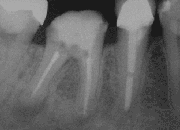
Photo from wikipedia
This in vitro study evaluated the apical sealing ability, bioactivity and biocompatibility of an experimental calcium silicate-based and two light-curing calcium silicate/calcium-phosphate cements as potential root end filling materials. A… Click to show full abstract
This in vitro study evaluated the apical sealing ability, bioactivity and biocompatibility of an experimental calcium silicate-based and two light-curing calcium silicate/calcium-phosphate cements as potential root end filling materials. A calcium silicate Portland-based (Control PC), an experimental calcium silicate (Exp. PC) and two light-curing cements (LC-CaP; LC-Si/CaP) were assessed for their alkalinising activity (pH) and biocompatibility. Single-rooted human canines were endodontically treated, filled with gutta-percha and finally submitted to apicoectomy. Root end fillings were performed using all tested cements, and their apical sealing ability was evaluated up to 4 weeks of immersion in simulated body fluid (SBF). The mineral precipitation at the apical region and the cement adaptation to root dentine were also evaluated through non-destructive optical microscopy both at 24 h and after prolonged water storage (four week). LC-CaP and LC-Si/CaP had neutral pH, the greatest sealing ability (24 h) and excellent cytocompatibility. The Exp. PC cement presented sealing ability after two and four weeks, as well as biocompatibility after four and seven days, similar to LC-CaP and LC-Si/CaP. The control PC cement showed the lowest sealing ability and the greatest cytotoxicity. Mineral precipitation was observed in all groups, while some differences were seen in terms of cement adaptation along the root canal dentine walls. The experimental light-curable cements as well as the experimental PC might be suitable root end filling materials with appropriate (in vitro) sealing ability, biocompatibility and aptitude to induce mineral precipitation.
Journal Title: Journal of Materials Science: Materials in Medicine
Year Published: 2017
Link to full text (if available)
Share on Social Media: Sign Up to like & get
recommendations!